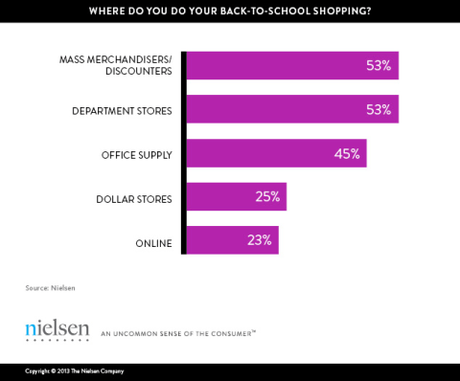 This is tax-free weekend in Tennessee and the crowds seem to be isolated to just a few stores like Apple? This Back to School season is expected to be down 7% from last years.
This is tax-free weekend in Tennessee and the crowds seem to be isolated to just a few stores like Apple? This Back to School season is expected to be down 7% from last years.
What is contributing to this slowdown in back-to-school sales? Some say that last year’s high sales were a response to pent-up demand. Economists say this year’s spending will be slower because shoppers are dealing with more expensive gasoline and higher payroll taxes. But I think there are other factors at work. Here are some contributing trends:
1. As schools move to more year-round calendars, families are shrinking the shopping list for the traditional Back-to-School time period. Finding data on the percentage of year-round schools is difficult. In 2008, the National Center for Education Statistics found 14 percent of U.S. public schools were on year-round calendars, with the largest percentage in the South and West. States are using tax holidays to encourage more back-to-school shopping in the fall.
2. Just-in-time shopping is lingering behavior from the recession. The needs that of each child tend to be spread over the school year, and parents are spreading the spending out to better manage their budgets. Almost half of all working Moms report they will re-use items from last year. Backpacks don’t wear out only in May and tennis shoes are not just needed in August. And coat purchases may wait until the first cold snap. And families are waiting until students get in the classroom to see what school supplies they really need. Retailers are seeing purchases much closer to the time of need. We don’t purchase fall fashions months ahead anymore.
Additionally, trend-savvy teens are spreading out their apparel spending over the year. One factor may be the rise of chains like H&M and Zara, fast fashion retailers that sell inexpensive clothing and are constantly bringing in new inventory to stay on trend. Another is the importance of comparison shopping and late-season clearance sales.

3. Online shopping also fuels just-in-time shopping. This year, Nielsen predicts that 21% of back-to-school shopping will happen online. In 2012, online sales were 7% of total retail spending and 10% of holiday spending, so you can see that back-to-school shopping is a heavy online shopping period. That means that shoppers are comparison shopping and getting those last minute needs online.
4. Smartphones and tablets have become more prolific and do not need to be replaced each year. And prices are going down as competition increases. According to BIGinsight’s study for the NRF, fewer families with children in grades K-12 will purchase electronics (55.7%) this year. Those who are purchasing a new tablet or smartphone are going to spend slightly less than last year ($199.05 vs. $217.88 in 2012).
5. Teen-agers have less to spend on their needs. While we are all so happy that the overall unemployment rate is around 7.4%, there has been no movement in the teen unemployment rate of 23.7%. Why is this important? Teens contribute to the household income in many families, providing for their own needs for school. Some 35% of teens help pay for back-to-school shopping. Over the past ten years, teen employment in a lot of traditional teen sectors, like retail or sales, has actually fallen, while the number of people who are age 55 and older has risen in those sectors. And so we’re just not seeing the types of opportunities for teens that maybe there were in the past.
How should marketers deal with these new trends? Realize that shopping is going to be more year-round. Online and offline shopping need to work together for busy moms. Women will expect new inventory more often and be able to buy it wherever, whenever they want. And maybe we just need to hire a student more often.
The Back to School shopping season is second only to holiday shopping. This year’s sales are expected to total $635 for the average family with school-age children, down from last year’s $689, according to the National Retail Federation.

